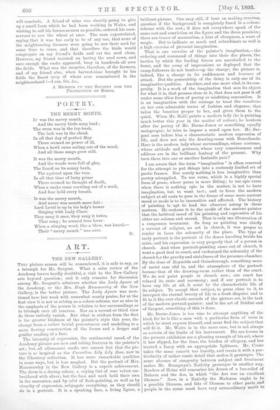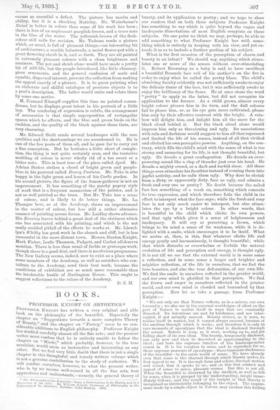ART.
THE NEW GALLERY.
This picture season will be remembered, it is safe to say, as a triumph for Mr. Sargent. What a calm review of the Academy leaves hardly doubtful, a visit to the New Gallery sets beyond question ; and it only remains for discussion among Mr. Sargent's admirers whether the Lady Agnew of the Academy, or the Mrs. Hugh Hammersley of the New Gallery, is the better picture. The Lady Agnew was men- tioned here last week with somewhat scanty praise, for at the first view it is not so seizing as a colour-scheme, nor so nice in the emphasis of the person in relation to her surroundings as to triumph over all reserves. Nor on a second or third view do these entirely vanish. But what is evident from the first is the greater kindness of the painter's style this year, the change from a rather brutal presentment and modelling to a more flowing construction of the forme and a. deeper and gentler reading of a face.
The intensity of expression, the sentimental mood, of the Academy picture are new and taking features in the painter's art ; but, all allowances made, one cannot feel that the pic- ture is so inspired as the Carnation Lily Lily Bose, now in the Chantrey collection. It has more remarkable qualities in some ways, but is less magical. But the portrait of Mrs. Hammersley in the New Gallery is a superb achievement. The dress is a daring colour, a crying tint of rose velvet em- broidered with silver; but the face and neck hold their own in the encounter, and by Mal of flesh-painting, as well as by vivacity of expression, subjugate everything, as they should do in a portrait. It is a speaking face, a living figure, a brilliant picture. One may still, if bent on making reserves, question if the background is completely fused in a colour- scheme with the rest; it does not everywhere speak of the same zest and conviction as the figure and the dress proclaim; there are traces of mannerism, a hint of cheapness, a want of magic. But to indicate so much and subordinate so well is a high exercise of pictorial imagination.
That is one exercise of the painter's imagination,—the ordering and command of things into their due places, the tactics by which the leading forces are marshalled to the front, and the army of impressions so deployed that the camp-followers do not lumber-up the charge; the picture is, indeed, like a charge in its suddenness and bravura of attack. But the generalship of the thing is only one of its imaginative qualities. Another, and one more vital, is its con- gruity. It is a work of the imagination that sees its object for what it is, that presses close to it, that does not pass it off under some alien form of poetry or misfitting convention. It is an imagination with the courage to treat the monclaine on her own admirable terms of fashion and elegance, that takes the beauties proper to her, and gives them to the quick. When Mr. Hallo paints a modern lady (he is painting much better this year in the matter of colour), he hankers after the poetry of Mr. Burne-Jones or something equally malapropos; he tries to impose a mood upon her. Mr. Sar- gent sees before him a characteristic modern expression of life, and does not mix the drawing-room with Broceliande. Here is the modern lady whose surroundings, whose costume, whose attitude and gestures, whose very consciousness and address are in the brilliant fantasy of the present. Why turn them into one or another fantastic past?
I am aware that the term "imagination" is often reserved
for the attempt to put things into a curiously limited set of poetic frames. Bat surely nothing is less imaginative than poetry misapplied. To use verse, which is a highly special form of prose, where prose is more fitting; to use epic verse when there is nothing epic in the matter, is not to have
but to want tact ; and to force the modern subject at all costs to pose in the frame of some more ancient mood or mode is to be insensitive and affected. The history of painting is 'apt to lead the observer astray in these- matters. He reckons it to the credit of the ancient painter that the habitual mood of his painting and expression of his. sitter are solemn and sacred. That is only one illustration of a congruous treatment. So long as painting was chiefly a servant of religion, an art in church, it was proper to. render in faces the solemnity of the place. The type of early portrait is the portrait of the donor kneeling beside his saint, and his expression is very properly that of a person in church. And when portrait-painting came out of church, it went a good deal to court, and exchanged the solemnity of the church kr the gravity and stateliness of the presence-chamber. By the time of Reynolds and Gainsborough, something more of social ease slid in, and the atmosphere of the portrait became that of the drawing-room rather than of the court.. We do not paint people in church now; our court has relaxed its state and ceremony ; and if our portrait is to have any life at all, it must be the characteristic life of its subject. To accept that subject, to press close to it, to interpret the eternal beauty of life in a fresh disguise, and to fit to it the ever elastic accords of the picture art, is the task of the modern portrait-painter; and in the art of Boldini and of Sargent, something of this is done.
Mr. Burne-Jones is too wise to attempt anything of the kind, for he is like a man with a particular form of verse in which be must express himself, and must find the subject that will fit it. Mr. Watts is in the same case, but is not always so certain of the limits of his instrument. His sea.horses in the present exhibition are a pleasing example of his art, where. it has slipped, for the time, the burden of allegory, and has treated a fancy with an appropriate lightness. Mr. Crane takes the same conceit too heavily, and treats it with a par- ticularity of rather comic detail that makes it grotesque. The same absence of congruity between subject and treatment makes Mr. Brangwyn's Nativity grotesque in another way. Readers of Heine will remember his dream of a bas-relief of Balaam and the Ass, in which "the Ass was an excellent likeness." Now, in a Nativity the Madonna ought to be a possible likeness, and bits of likeness to other, parts and people in the scene must have very extraordinary merit to excuse so essential a defect. The picture has merits and ability, but it is a shocking Nativity. Mr. Waterhouse's Naiad is better in colour than some of his work has been ; there is less of an unpleasant purplish-brown, and a truer note in the blue of the water. The yellowish-brown of the flesh. Colourstill calls for revision. Mr. Tadema sends a picture which, as usual, is full of pleasant things,—an interesting bit of architecture, a marble balustrade, a metal flower-pot with a great flowering shrub in it, and so forth. They are all painted in extremely pleasant colours with a clean brightness and neatness. The pot and shrub alone would have made a pretty bit of still-life, but the people introduced, like little chimney. piece ornaments, and the general confusion of scale and equable, dispersed interest, prevent the collection from making the appeal exactly of a picture. It is to great painting what an elaborate and skilful catalogue of precious objects is to a poet's description. The latter would unite and relate them by some one motive.
M. Fernand Khnopff supplies this time no painted conun- drums, but he displays great talent in his portrait of a little boy. The rendering of expression is subtle, the arrangement of accessories is that simple superposition of rectangular spaces which he affeets, and the blue and green birds on the cushion, and the quality of the black against those tints, are very charming.
Mr. Edward Stott sends several landscapes with the rare qualities and the shortcomings we are accustomed to. He is one of the few poets of them all, and he goes far to carry out a fine conception. But he hesitates a little short of comple- tion, the thing is not quite certainly seen, and the tentative mottling of colour is never wholly rid of a too sweet or a bitter note. This is least true of the piece called April. Mr. Adrian Stokes strikes a chord of bright green and purple- blue in his pastoral called Breezy Pastures. Mr. Tuke is also happy in the light green and lemon of his Corfu garden. In his second picture, the figure of the lemon-gatherer is not an improvement. It has something of the patchy papery style of work that is a frequent mannerism of the painter, and is not so well painted as the trees. But Mr. Take has a sense of colour, and is likely to do better things. Mr. La Thangue here, as at the Academy, shows an improvement in the matter of colour, but has still a rather obtrusive manner of painting across forms. Mr. Laidlay shows advance. His Evening leaves behind a great deal of the slatiness which one has associated with his painting, and which is the not easily avoided pitfall of the effects he works at. Mr. Llewel- lyn's Whitby has good work in the church and cliff, but is less successful in the more distant town. Messrs. Buxton Knight, Mark Fisher, Leslie Thomson, Padgett, and Corbet all deserve mention. There is less than usual of feeble or grotesque work, though there is a good deal, and there is no obvious programme. The New Gallery seems, indeed, now to exist as a place where some members of the Academy, as well as outsiders who con- tribute to the Academy, send their best work, because the conditions of exhibition are so much more reasonable than the intolerable hustle of Burlington House. This ought to suggest reflections to the rulers of the Academy. D. S. M.







































 Previous page
Previous page